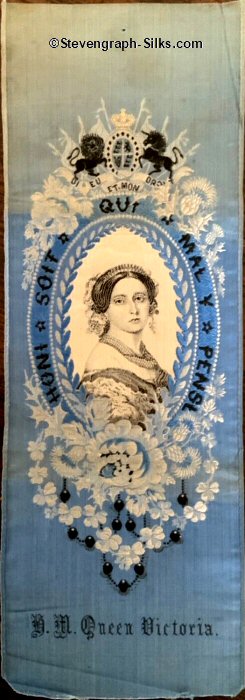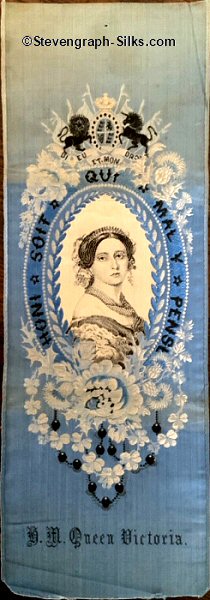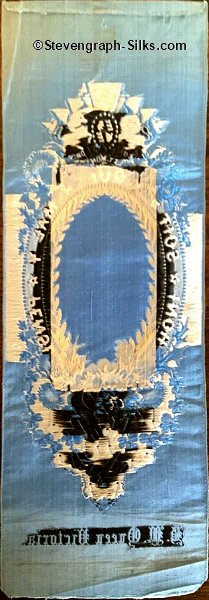This is a most unusual ribbon for Stevens to have made, and is completely different to anything else attributed to his manufacture. As it is still attached to the stiff backing paper, with the embossed Stevens name, there can be no doubt as to its authenticity.
This actual ribbon itself, and image, are owned by The Herbert Art Gallery & Museum, Coventry, who retain the copyright. The original image can be seen in the Herbert Museum on-line archive.
As can be seen in the three images above, this ribbon was issued in various colours, and both with and without Victoria's name woven in the design. It is not known why this ribbon was made. If it had been intended as a bookmark, there would be a woven pattern for the relevant creases at the pointed end, and the STEVENS name would have been woven at top or bottom turn-over. There is no such pattern or weaving.
It is possible this ribbon was intended to be mounted as a portrait, although as its overall size would be very narrow for a typical portrait, this seems unlikely.
There is some suggestion this might have been an experimental weaving of Stevens, although with the different background colours, and with the inclusion of Victoria's name on only some of the designs, it would seem this was a specific weave, and probably intended for sale.
However, there is a very interesting, and unusual back to this ribbon. In a " normal " weave, the back would be a reverse of the front design. In this ribbon, as can be clearly seen in the image to the left, there is a completely different " patch " behind the actual, central white area portrait of Victoria.
The weave direction of this patch is at right angles to that of the main design, suggesting two different weavings bought together. This patch though seems to have been woven into the main design in some way, not attached later. This is evident as the back of this patch is blue, not the expected black and white reverse image of Victoria, suggesting the main colour continued over the top of this patch. I have no idea how this was achieved, although a member of the Stevengraph Association investigated further and discovered that this arrangement was quite usual on French silk ribbons at the time.
Based on no information at all, it might be that Stevens looked carefully at the French weaving methods; bought those back to Coventry to experiment with; leading to his development of the looms he became famous for?





